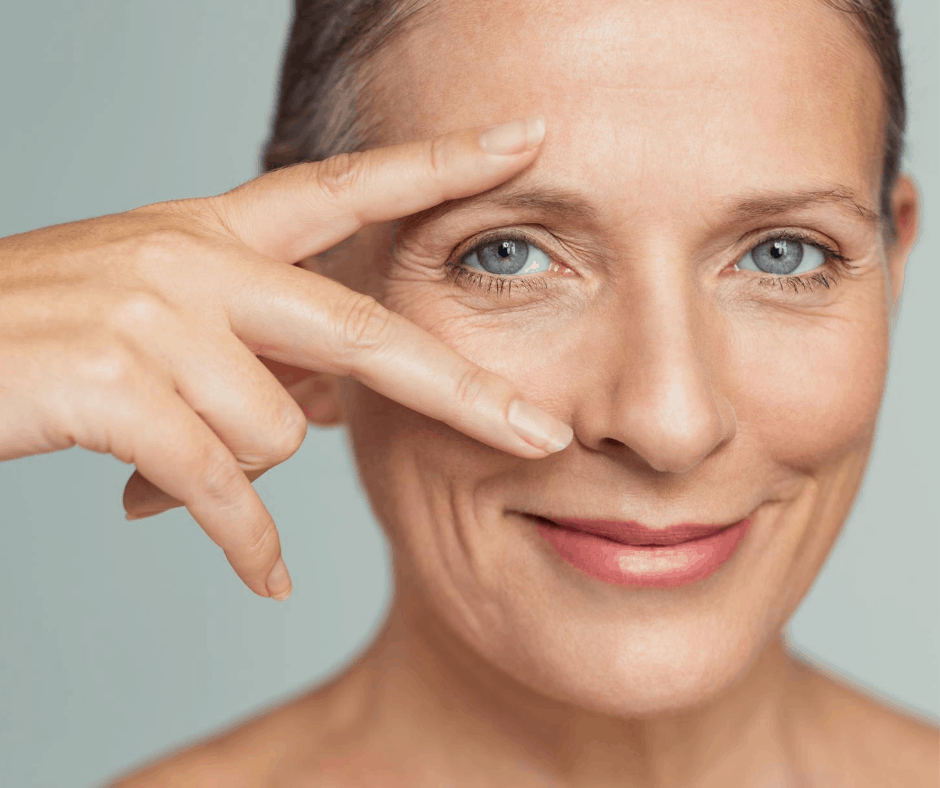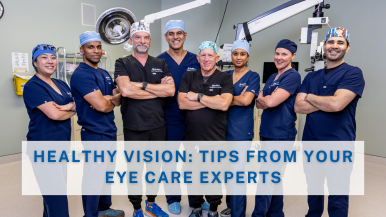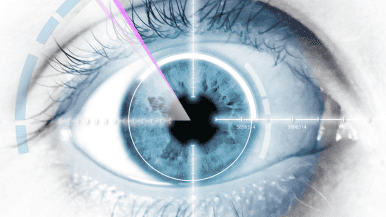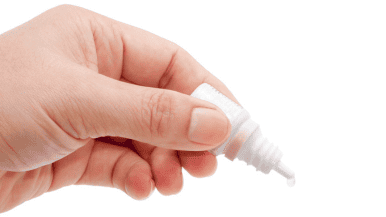- What is dry eye?
- What causes dry eye?
- What are the symptoms of dry eye?
- When should I see my doctor?
- How do you treat dry eye?
How can a dry eye water and still be considered “dry?” It doesn’t seem to make sense, but when you suffer from dry eye, your eyes can become irritated and may begin leaking tears. That’s because the lacrimal glands produce so many tears from being irritated that they completely overwhelm the eye’s natural drainage systems.
Leaky, red, and uncomfortable eyes are the result.
What Is Dry Eye?
Your vision is incredibly important but it’s something you may take for granted – unless it begins to fail or cause problems. Your eye is a particularly delicate structure, taking in light and converting it into a signal that the brain can understand. It has many parts that work together, including the tears that your eyes produce. In fact, a healthy tear film is critical for producing a sharp, crisp image. There are a number of different diseases and problems that can crop up in the eye, making regular preventative visits to your ophthalmologist a necessity for their care.
Dry eye is a chronic condition that can be very uncomfortable and is far too common in older adults. The American Optometric Association describes the disorder in this way:
“Dry eye is a condition in which a person doesn’t have enough quality tears to lubricate and nourish the eye. Tears are necessary for maintaining the health of the front surface of the eye and providing clear vision. Dry eye is a common and often
chronic problem, particularly in older adults.”
The American Academy of Ophthalmology (AAO) reports that nearly five million Americans over 50 years old suffer from dry eye. The good news is that this is a very treatable disorder.
What Causes Dry Eye?
Dry eye occurs when your eyes don’t produce a sufficient amount of tears to lubricate the eye.
 Interestingly, your tears do much more than signal you’re having a bad day; they serve an evolutionary purpose as the eyes natural cleansing agent. Each time you blink, tears spread across the cornea, or surface of your eyes, to nourish and lubricate the organ.
Interestingly, your tears do much more than signal you’re having a bad day; they serve an evolutionary purpose as the eyes natural cleansing agent. Each time you blink, tears spread across the cornea, or surface of your eyes, to nourish and lubricate the organ.
Think of your tears like the rain on your car windshield. The eyelids are like windshield wipers, wiping away the surface debris. When the eyes blink, the eyelids sweep away the excess moisture and debris from your eye and into small drainage ducts in the inside corners of your eyelids. That fluid then flows into the back of the nose. At the same time, the eyelids release lubricating oil from specialized glands near the eyelashes. When this delicate and important system gets out of balance, dry eyes are the result.
Common causes of dry eye:
- The natural aging process causes most people over age 65 to be afflicted with dry eye
- Women are more often afflicted by dry eye due to hormonal changes after menopause
- Some medications such as antihistamines, blood pressure pills or decongestants can disrupt normal tear production
- People with chronic conditions such as diabetes, rheumatoid arthritis, or thyroid problems are more likely to develop dry eye
- Your environment can cause dry eye, including exposure to wind and dry climates or smoke, or decreased blinking from staring at a computer or TV screen
- Long-term use of contact lenses
- Prior cataract surgery or LASIK may decrease tear production
- Skin diseases around the eyes or diseases of the eye glands
- Some autoimmune disorders such as rheumatoid arthritis
- Chronic allergies
The tear film which covers the eye is made up of three layers
- An aqueous layer consisting of saltwater produced by the lacrimal and accessory glands. This makes up most of the tear film.
- A mucin (mucous) layer, produced by specialized goblet cells, that binds the aqueous layer to the surface of the eye
- A lipid (oil) layer that covers the surface of the aqueous layer to prevent it from evaporating. This oil is produced by the meibomian glands located in the lid margins.
There are two types of dry eye:
- Aqueous deficiency dry eye is caused by diminished tear production and is due to a multitude of issues such as hormonal changes, medications, injury, or mechanical factors like poor eyelid function. This occurs in about one-third of dry eye cases.
- Evaporative dry eye is caused by a decrease in meibomian gland lipid production either due to obstruction of the glands or loss (atrophy) of the glands. This accounts for about two-thirds of dry eye cases although there is frequently overlap with aqueous deficiency dry eye.
Dry Eye Syndrome vs Dry Eye Disease
Most patients who have dry eye symptoms suffer from what is known as Dry Eye Syndrome, in which the eyes feel like they are not getting the normal amount of lubrication. In most of these cases, the eye exam might actually be normal although there will usually be clues that tear production is compromised.
However, if the doctor finds on the exam that there is actually dryness of the surface of the eye, this implies that the tear deficiency is more severe because the eye cannot maintain a healthy surface. This is referred to as Dry Eye Disease and is more serious because, without a healthy surface, the eye is at risk for infections or more serious problems.
Depending on the cause or the part of the eye affected, dry eye has a number of other names including:
- Keratoconjunctivitis sicca
- Dysfunctional tear syndrome
- Lacrimal keratoconjunctivitis
- Exposure keratopathy
All of these conditions result in the same basic problem: An eye that fails to self-lubricate normally, causing discomfort in the affected person.
What Are the Symptoms of Dry Eye?
No matter the name, dry eye can be a very uncomfortable disorder that can cause:
- Blurred vision
- Burning, stinging, or scratchy eyes
- Itching
- Difficulty wearing contacts
- Eye fatigue
- Eye redness
- Light sensitivity
- Mucus in or around the eyes
- Poor vision when driving at night
When Should I See My Eye Doctor?
 If you suffer from any of these symptoms, you should see an ophthalmologist. In addition to being painful or uncomfortable, people with dry eyes may experience complications from the disorder including:
If you suffer from any of these symptoms, you should see an ophthalmologist. In addition to being painful or uncomfortable, people with dry eyes may experience complications from the disorder including:
- Eye infections
- Eye surface damage
- Lowered quality of life
How Do You Treat Dry Eye?
Your ophthalmologist will work with you to determine the cause of your dry eye by conducting a thorough exam and medical history.
At Ocala Eye, we develop a personalized treatment regime based on a thorough examination of the entire eye structure and function. This includes special testing at our Dry Eye Center, the first of its kind in the area. In addition to a variety of medications, our practice offers some of the most innovative and effective treatments to alleviate dry eye symptoms in our patients. For example:
- The LipiFlow and iLUX procedures apply controlled heat and compression to the inner eyelid to help unblock the meibomian gland
- MiBo Thermoflo is a therapeutic medical device that provides safe, affordable and effective therapy for patients with meibomian gland dysfunction
- Bleph-Ex uses a micro-sponge to exfoliate and clean the eyelids and lashes, which removes clogging debris from the lid margins
How Do You Treat Dry Eye?
Your ophthalmologist will work with you to determine the cause of your dry eye by conducting a thorough exam and medical history.
At Ocala Eye, we develop a personalized treatment regime based on a thorough examination of the entire eye structure and function. This includes special testing at our Dry Eye Center, the first of its kind in the area. In addition to a variety of medications, our practice offers some of the most innovative and effective treatments to alleviate dry eye symptoms in our patients. For example:
- The LipiFlow and iLUX procedures apply controlled heat and compression to the inner eyelid to help unblock the meibomian gland
- MiBo Thermoflo is a therapeutic medical device that provides safe, affordable and effective therapy for patients with meibomian gland dysfunction
- Bleph-Ex uses a micro-sponge to exfoliate and clean the eyelids and lashes, which removes clogging debris from the lid margins




